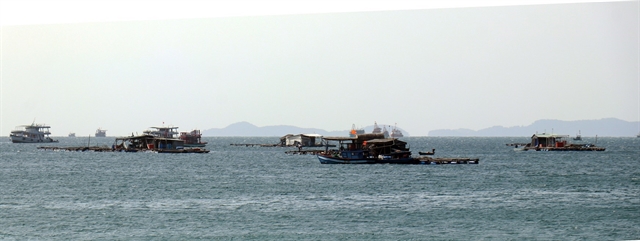 Society
Society


|
| Floating fish cages in Kiên Giang Province’s Phú Quốc City. – VNA/VNS Photo Lê Huy Hải |
KIÊN GIANG – The Cửu Long (Mekong) Delta province of Kiên Giang targets an average annual growth rate of 24 per cent for marine aquaculture from now to 2030.
With a coastline of more than 200km and many large and small islands, Kiên Giang has the largest number of floating cages for breeding marine aquatic species in the delta.
It aims for an annual output of 113,530 tonnes for marine fish and other aquatic species by 2025 and 207,190 tonnes by 2030.
The province targets having 7,500 floating aquaculture cages on a total of 7,000ha by 2025 and 14,000 floating cages on a total of 16,000ha of sea surface by 2030.
Both traditional and high-tech breeding methods will be used.
The province also plans to breed pearl oysters on 200ha and bivalve mollusks on a total area of 25,000ha by 2030.
To meet the targets, the province needs VNĐ12.7 trillion (US$550 million) for marine aquaculture in the 2021- 30 period. The investment money will be come from central and local budgets and marine aquaculture breeders.
The province will also provide farmers breeding techniques and help near-shore fishermen switch to breeding marine fish to reduce overfishing in the area.
Marine fish like groupers, cobia, sea bass, lobsters, mantis shrimp, blue swimmer crabs and pearl oysters will be bred on islands in Phú Quốc City, Kiên Hải District, Hà Tiên City’s Tiên Hải Commune and Kiên Lương District’s Sơn Hải and Hòn Nghệ communes.
Coastal areas in Hà Tiên City and the districts of Kiên Lương, Hòn Đất, An Minh and An Biên will breed bivalve mollusks like blood cockles, green mussels and ark clams.
The province plans to develop its marine aquaculture sustainably on an industrial scale to serve domestic consumption and exports, and create linkages among stakeholders to improve production value.
It has encouraged large-scale marine aquaculture companies to invest in high-tech marine aquaculture. In recent years, several companies have invested in the breeding of marine fish, such as floating cages used with Norwegian techniques.
The Trấn Phú Trading and Import- Export Co., Ltd, for example, is breeding marine fish in floating cages with Norwegian techniques in Phú Quốc City. And the Mavin Group is investing in breeding marine fish in 2,000ha of water off the coast of Kiên Hải District for export.
High profits
Kiên Giang has about 4,500 floating cages on the sea for marine aquatic species breeding, mostly near islands, according to the province’s Department of Agriculture and Rural Development.
Breeding marine fish in floating cages offers high profits for households living in coastal areas and islands.
In Kiên Hải Island District, farmers who breed grouper, cobia and other marine fish species in floating cages in An Sơn, Nam Du and Lại Sơn communes earn a profit of hundreds of millions of đồng a year.
Marine fish are bred in floating rafts that often have 4 - 6 fish cages each.
Nguyễn Văn Năm, who has eight floating fish cages in Kiên Hải’s Lại Sơn Commune, said farmers can earn a profit of VNĐ50 million ($2,160) for an 18-month fish crop in a floating fish cage.
“If using proper breeding techniques and having quality fish-fry, farmers can earn a profit margin of 100 per cent,” he said.
In Lại Sơn, more than 100 households breed marine fish in about 700 floating cages, with an annual output of more than 1,000 tonnes.
Lại Sơn commune has the highest density of floating cages in Kiên Giang.
Lại Sơn, An Sơn and Nam Du communes have offered breeding training for farmers and regularly provide them with information about weather and diseases.
The commune has encouraged farmers to set up co-operatives to improve production value and income. The Tiến Đạt Co-operative in Lại Sơn, for instance, has 10 members who breed marine fish in floating cages and offer tourism services on their floating cages.
Local authorities and farmer associations have supported farmers with soft loans and breeding techniques.
The Hòn Nghệ Commune Farmers Association in Kiên Lương District, for example, has encouraged households that have financial capacity to invest in breeding marine fish and join with other less financially capable households and share the profits.
The model, begun in 2016, has worked effectively, according to the association. Less financially capable households have earned a profit of VNĐ250-300 million ($10,800 – 13,000) a year.
The association has worked with the province’s Fund for Support Farmers to provide soft loans worth a total of VNĐ1.3 billion ($56,300) to 46 marine-fish breeding households in Hòn Nghệ since 2016. – VNS




